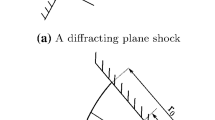Abstract
The influence of artificial disturbances on the behavior of strong converging cylindrical shocks is investigated experimentally and numerically. Ring-shaped shocks, generated in an annular cross sectional shock tube are transformed to converging cylindrical shocks in a thin cylindrical test section, mounted at the rear end of the shock tube. The converging cylindrical shocks are perturbed by small cylinders placed at different locations and in various patterns in the test section. Their influence on the shock convergence and reflection process is investigated. It is found that disturbances arranged in a symmetrical pattern will produce a symmetrical deformation of the converging shockfront. For example, a square formation produces a square-like shock and an octagon formation a shock with an octagonal front. This introduces an alternative way of tailoring the form of a converging shock, instead of using a specific form of a reflector boundary. The influence of disturbances arranged in non-symmetric patterns on the shape of the shockfront is also investigated.
Similar content being viewed by others
References
Apazidis N., Lesser M., Tillmark N. and Johansson B. (2002). An experimental and theoretical study of converging polygonal shock waves. Shock waves 12: 39–58
Apazidis N. and Lesser M. (1996). On generation and convergence of polygonal-shaped shock waves. J. Fluid Mech. 309: 301–319
Watanabe, M., Onodera, O., Takayama, K.: Shock wave focusing in a vertical annular shock tube. In: Brun, R., Dimitrescu, L.Z. (eds.) ShockWaves@Marseille vol. 4, pp. 99–104. Springer, Berlin (1995)
Bryson A.E. and Gross R.W.F. (1961). Diffraction of strong shocks by cones, cylinders and spheres. J. Fluid Mech. 10: 1–16
Eliasson V., Apazidis N., Tillmark N. and Lesser M.B. (2006). Focusing of strong shocks in an annular shock tube. Shock waves 15: 205–217
Perry R.W. and Kantrowitz A. (1951). The production and stability of converging shock waves. J. Appl. Phys. 22: 878–886
Schwendeman D. and Whitham G. (1987). On converging shock waves. Proc. R. Soc. Lond. A A413: 297–311
Sun M. and Takayama K. (2003). An artificially upstream flux vector splitting scheme for the euler equations. J. Comput. Phys. 189: 305–329
Takayama K., Onodera O. and Hoshizawa Y. (1984). Experiments on the stability of converging cylindrical shock waves. Theor. Appl. Mech. 32: 305–329
Takayama K., Kleine H. and Gröning H. (1987). An experimental investigation of the stability of converging cylindrical shock waves in air. Exp. Fluids 5: 315–322
Watanabe M. and Takayama K. (1991). Stability of converging cylindrical shock waves. Shock Waves 5: 149–160
Whitham G. (1957). A new apporach to problems of shock dynamics. Part 1. Two-dimensional problems. J. Fluid Mech. 2: 145–171
Whitham G. (1958). On the propagation of shock waves through regions of non-uniform area or flow. J. Fluid Mech. 4: 337–360
Whitham G. (1959). A new approach to problems of shock dynamics. Part 2. Three-dimensional problems. J. Fluid Mech. 5: 369–386
Author information
Authors and Affiliations
Corresponding author
Additional information
Communicated by K. Takayama.
Rights and permissions
About this article
Cite this article
Eliasson, V., Apazidis, N. & Tillmark, N. Controlling the form of strong converging shocks by means of disturbances. Shock Waves 17, 29–42 (2007). https://doi.org/10.1007/s00193-007-0087-9
Received:
Accepted:
Published:
Issue Date:
DOI: https://doi.org/10.1007/s00193-007-0087-9




